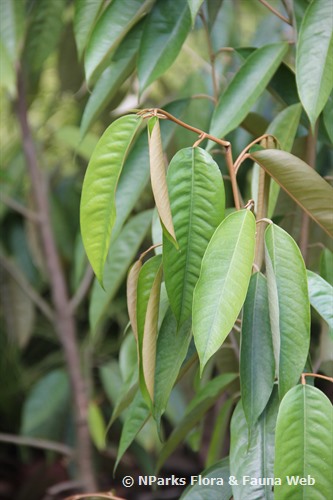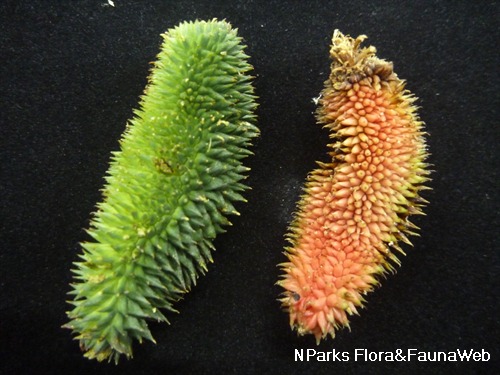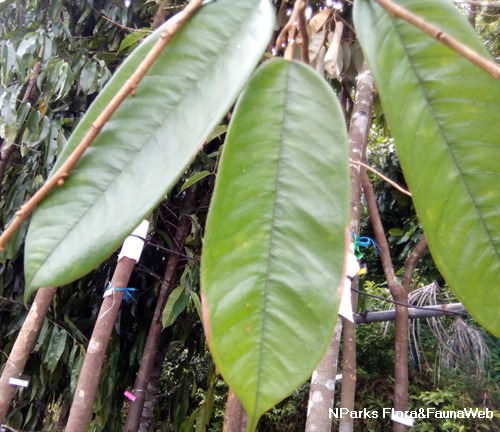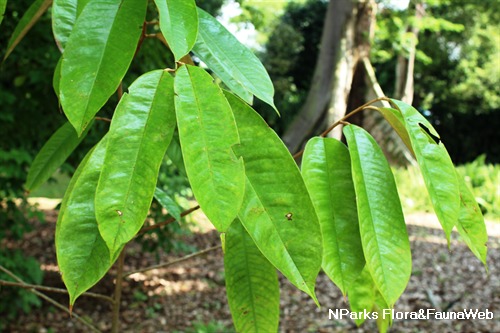
Back
Durio zibethinus L.
| Family Name: | Malvaceae |
| Synonyms: | Durio acuminatissimus Merr. |
| Common Name: | Durian, Durian Kampong, 榴莲 |
Durio zibethinus, commonly known as Durian, is a tree that can grow up to 25 m tall. It bears large, spiny fruits that ripen green and are highly prized for their edible yellowish arils, known for their sweet, creamy texture and distinctive strong aroma.
Name
Classifications and Characteristics
| Plant Division | Angiosperms (Flowering Seed Plants) (Dicotyledon) |
|---|---|
| Plant Growth Form | Tree (Big (>30m)) |
| Lifespan (in Singapore) | Perennial |
| Mode of Nutrition | Autotrophic |
| Plant Shape | Rounded |
| Maximum Height | 25 m |
Biogeography
| Native Distribution | Sumatra and Borneo |
|---|---|
| Native Habitat | Terrestrial |
| Preferred Climate Zone | Tropical |
| Local Conservation Status | Non-native |
Description and Ethnobotany
| Growth Form | This is a tall tree with an upright growth habit, and a short, straight trunk with rough and peeling bark. The crown is large, irregular, and may range from dense to fairly open with bare branches. |
|---|---|
| Foliage | Leaves are oblong, rounded at the base with pointed tips. They are discolourous, being green and glossy on the upper surface and silvery or bronze on the underside. Individual leaves are 6 - 20cm long and 3 - 9cm wide, occurring in an alternate arrangement. |
| Flowers | The bright yellow flowers are cauliflorous, produced directly on large branches in clusters of up to 30 flowers. Each flower has three petals, 5 - 7cm wide, with a bell-shaped calyx. The flowers bloom at night, releasing a strong odour to attract bats which are the main pollinators. |
| Fruit | The fruits are coated with a hard and thorny husk that ranges in colour from green to brown. The seeds are covered with a fleshy aril, ranging from white to yellow. The flesh has a unique and strong odour, which is apparent even when the husk is not broken. It is edible and is known as the "King of Fruits" in Southeast Asia, but the strong odour and creamy texture of the flesh make it an acquired taste. Fruiting occurs once or twice a year, with the primary season in May to June. |
| Cultivation | Propagated by seed or grafting. Seeds must be planted fresh as they quickly lose viability. Seeds will germinated in about a week. Plants are also be grafted. Grafted trees begin bearing fruit within 4 - 5 years. Does well in deep, loamy and well-drained soil high in organic matter. A pH range of 6 - 7 is ideal. Avoid peaty or sandy and poorly drained soils, as the root system is sensitive to standing water. For durian cultivation, gently sloping terrain is ideal. |
| Etymology | The genus Durio is the Malayan name for the durian fruit. The specific epithet zibethinus is taken after foul-smelling fruits of durian. |
| Ethnobotanical Uses | Food (Fruit or Vegetable): The flesh surrounding the seeds is mostly eaten fresh. It is commonly found in Southeast Asia. It may also be canned in syrup for export, or frozen. It is also dried for local use and export. The seeds themselves are also edible after boiling, drying and frying, or roasting. In Java, seeds are thinly sliced and cooked with sugar as a confection. Young leaves and shoots are occasionally cooked as greens. In Malaysia, the flowers are stir-fried and eaten with chili and soy-sauce. Medicinal: The flesh is said to serve as a vermifuge, while the leaves and roots are decocted and used as a febrifuge. Juices from the leaves are applied to the head of patients with fever. The leaves are also used in medicinal baths for patients with jaundice. Decoctions of the leaves and fruits are applied to swellings and skin diseases. Cultural / Religious: Heritage Tree : There is currently one individual of Durio zibethinus listed as a Heritage Tree in Singapore. It can be found on Pulau Ubin. To find out more about these trees, please visit the Heritage Tree Register. Others: The wood is used to build the interiors of huts and for masts in Malaysia. |
Landscaping Features
| Desirable Plant Features | Fragrant (Flowers) (Night) |
|---|---|
| Usage Hazard - Cons | Spines/Thorns - Fruit |
Fauna, Pollination and Dispersal
| Pollination Method(s) | Biotic (Fauna) (Vertebrates (Bat)) |
|---|---|
| Seed or Spore Dispersal | Biotic (Fauna) |
Plant Care and Propagation
| Light Preference | Full Sun |
|---|---|
| Water Preference | Moderate Water |
| Plant Growth Rate | Moderate |
| Rootzone Tolerance | Moist Soils, Well-Drained Soils, Fertile Loamy Soils |
| Pest(s) | Vertebrates (Herbivores) |
| Propagation Method | Seed, Grafting |
Foliar
| Foliage Retention | Evergreen |
|---|---|
| Mature Foliage Colour(s) | Green, Brown |
| Mature Foliage Texture(s) | Glossy / Shiny |
| Prominent Young Flush Colour(s) | Brown, Green |
| Young Flush Texture(s) | Glossy / Shiny |
| Foliar Type | Simple / Unifoliate |
| Foliar Arrangement Along Stem | Alternate |
| Foliar Attachment to Stem | Petiolate |
| Foliar Shape(s) | Non-Palm Foliage (Oblong) |
| Foliar Venation | Pinnate / Net |
| Foliar Margin | Entire |
| Foliar Apex - Tip | Acute |
| Foliar Base | Rounded / Obtuse |
| Leaf Area Index (LAI) for Green Plot Ratio | 3.0 (Tree - Intermediate Canopy) |
Floral (Angiosperm)
| Flower & Plant Sexuality | Bisexual Flowers |
| Flower Colour(s) | White, Yellow / Golden |
|---|---|
| Flower Texture(s) | Smooth |
| Flower Grouping | Cluster / Inflorescence |
| Flower Location | Cauliflorous |
| Flower Symmetry | Radial |
| Individual Flower Shape | Campaulate / Bell-shaped |
| Flowering Period | A Few Times Yearly |
| Flowering Opening Time | Night (dusk to dawn) |
| Flower Lifespan on Plant | 1 Night |
Image Repository
Others
| Master ID | 1572 |
|---|---|
| Species ID | 2865 |
| Flora Disclaimer | The information in this website has been compiled from reliable sources, such as reference works on medicinal plants. It is not a substitute for medical advice or treatment and NParks does not purport to provide any medical advice. Readers should always consult his/her physician before using or consuming a plant for medicinal purposes. |












.jpg)